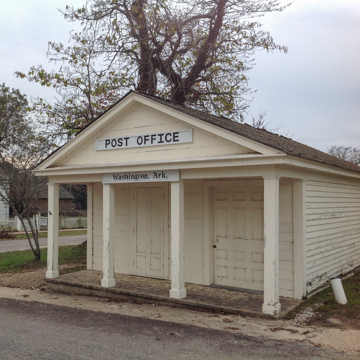Washington is a preservation tourist’s dream: it is the site of Historic Washington State Park, a living history museum comprising several dispersed buildings, some on their original sites, and some moved to within the boundaries of the park. All contribute to the history of the tiny town, both as it was and as it would like to be understood. A convenient early-nineteenth-century stopover on the Southwest Trail between St. Louis and Texas, the hamlet claimed Davy Crockett, William Travis, and Sam Houston as onetime residents, leading some to suggest Washington as the planning site for the Texas Revolution. There is diversity in the architecture: most of the restored houses are fine examples of Greek Revival design as it was disseminated in such remote outposts during the first half of the nineteenth century, while other buildings, such as the Italianate-styled 1874 Hempstead County Courthouse, exhibit styles more popular toward that century’s close. Not to be missed is the courthouse’s predecessor, the 1836 Hempstead County Courthouse, a stripped-down Greek Revival structure that served briefly as the Confederate Capitol of Arkansas following the fall of Little Rock in 1863. Also preserved is the 1914 Washington High School, a substantial and fine example of Progressive Era design; across the street is a re-created working blacksmith’s shop (where fine examples of Bowie knives are on display). An interesting inclusion is the more recently restored Gymnasium building, a project of the WPA from the 1930s, suggesting a less preserved-in-amber direction for future interpretations.
As an ensemble, these museum structures suggest a cleaned-up depiction of daily life from an earlier day. The collection of buildings makes for an interesting parade through nineteenth-and early-twentieth-century popular architectural tastes as they made their appearances in the provinces, while offering some evidence of long-standing diversity: the Federal-styled Block-Catts House of 1832 was home to the earliest known Jewish settlers in what was then Arkansas Territory. Still, the lives of the well-to-do are predominantly chronicled, while the role of slave culture in the construction of the town is hardly acknowledged. Preserved flora is also important to the Washington experience; several historic trees, including an immense Magnolia grandiflora (dating to the 1830s), a spectacular and still-producing pecan tree, and the Arkansas State Champion catalpa, and Durand oak trees are found here.


















